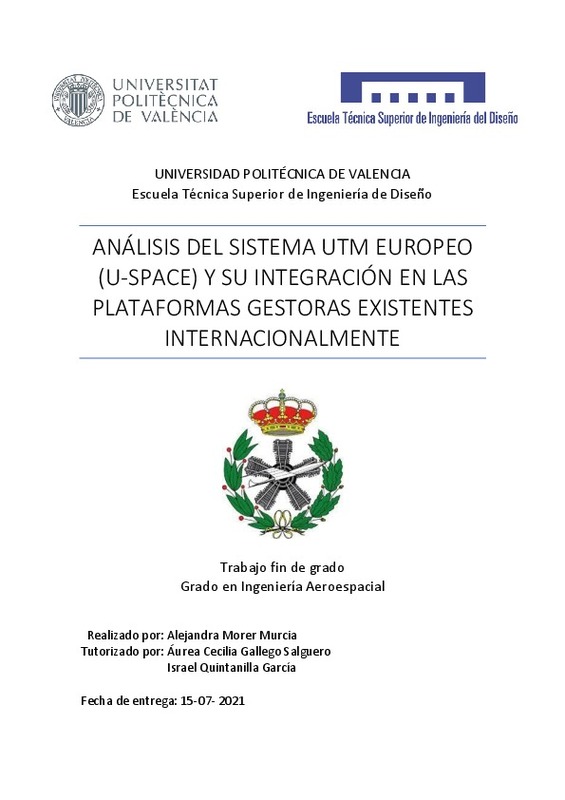JavaScript is disabled for your browser. Some features of this site may not work without it.
Buscar en RiuNet
Listar
Mi cuenta
Estadísticas
Ayuda RiuNet
Admin. UPV
Análisis del sistema UTM europeo (U-Space) y su integración en las plataformas gestoras existentes internacionalmente
Mostrar el registro sencillo del ítem
Ficheros en el ítem
| dc.contributor.advisor | Gallego Salguero, Áurea Cecilia
|
es_ES |
| dc.contributor.advisor | Quintanilla García, Israel
|
es_ES |
| dc.contributor.author | Morer Murcia, Alejandra
|
es_ES |
| dc.coverage.spatial | east=13.210934817790987; north=47.26784848419983; name=Labenbach, 5611, Àustria | es_ES |
| dc.date.accessioned | 2021-09-07T14:50:09Z | |
| dc.date.available | 2021-09-07T14:50:09Z | |
| dc.date.created | 2021-07-26 | |
| dc.date.issued | 2021-09-07 | es_ES |
| dc.identifier.uri | http://hdl.handle.net/10251/171606 | |
| dc.description.abstract | [ES] Se denomina vehículo aéreo no tripulado, UAS (Unmanned Aircraft Systems), a una aeronave que desarrolla un vuelo sin tripulación, comúnmente conocidos como drones. Desde 1944 en el Convenio de Chicago se habla de drones y de que estos elementos tendrían que ser regulados por una normativa competente. La industria de los UAS ha ido desarrollándose exponencialmente a lo largo de los años, hasta que a día de hoy nos encontramos ante un sector en plena expansión que envuelve a todos los medios del sector aeroespacial. El aumento de la fabricación de estas aeronaves y su inclusión en todo tipo de espacios aéreos ha creado la necesidad de desarrollar una normativa que dé servicio a las actuaciones de los UAS. Es por ello que la integración de los UAS con el resto de aeronaves que ocupan el espacio aéreo es imprescindible para tener una red segura de rutas aéreas. Ante esta situación, el concepto UTM (Unmanned Traffic Management) es la solución y U-Space será el sistema concreto de UTM para su implementación en Europa. De esta forma, en este trabajo se analizará la situación actual que existe referente al proyecto en desarrollo del U-Space, su arquitectura, servicios y plataformas de implementación. Con ello, se considerará la normativa que busca integrar este sistema con el ATM de forma que ambos puedan coexistir en el mismo espacio ofreciendo una red aérea segura. Así, se expondrá el futuro funcionamiento del sistema de uso de drones. A su vez, se hará un estudio más exhaustivo de las soluciones que se proponen para el servicio de geolocalización de los drones y las aplicaciones que lo implementan | es_ES |
| dc.description.abstract | [EN] An Unmanned Aerial Vehicle, UAS (Unmanned Aircraft Systems), is an aircraft that develops an unmanned flight, exceptionally known as drones. Since 1944, the Chicago Convention has talked about drones so that these elements should be regulated by a competent normative. The UAS industry has been increasing and expanding exponentially over the years, until today, when we are facing a sector in full expansion that involves all media in the aerospace sector. The rise in the manufacture of these aircrafts and their inclusion in all types of airspaces has created the need to develop regulations that attend the operations that UAS are capable of running nowadays. For this reason, the integration of the UAS with the rest of the aircrafts that occupy the airspace is essential in order to have a safe network of air routes. Faced with this situation, the UTM (Unmanned Traffic Management) concept is the solution and USpace will be the specific UTM system for its implementation in Europe. In this way, this draft will analyze the current situation regarding the U-Space project under development, its architecture, services and implementation’s platforms. In addition, the regulations that seek to integrate this system with the ATM will be considered so that both can coexist in the same space offering a secure air network for all types of aircrafts. Thus, the future operation of the drone use system will be exposed. Also, the solutions that are proposed for the geolocation service of drones and the applications that implement it will be studied in an exhaustive way | es_ES |
| dc.format.extent | 84 | es_ES |
| dc.language | Español | es_ES |
| dc.publisher | Universitat Politècnica de València | es_ES |
| dc.rights | Reconocimiento - No comercial (by-nc) | es_ES |
| dc.subject | UTM | es_ES |
| dc.subject | ATM | es_ES |
| dc.subject | UAS | es_ES |
| dc.subject | Normativa | es_ES |
| dc.subject | Espacio aéreo | es_ES |
| dc.subject | U-Space | es_ES |
| dc.subject | Servicios aeronáuticos | es_ES |
| dc.subject | Geolocalización | es_ES |
| dc.subject | Seguridad aérea | es_ES |
| dc.subject | Proveedores de servicios | es_ES |
| dc.subject.classification | INGENIERIA CARTOGRAFICA, GEODESIA Y FOTOGRAMETRIA | es_ES |
| dc.subject.other | Grado en Ingeniería Aeroespacial-Grau en Enginyeria Aeroespacial | es_ES |
| dc.title | Análisis del sistema UTM europeo (U-Space) y su integración en las plataformas gestoras existentes internacionalmente | es_ES |
| dc.type | Proyecto/Trabajo fin de carrera/grado | es_ES |
| dc.rights.accessRights | Abierto | es_ES |
| dc.contributor.affiliation | Universitat Politècnica de València. Departamento de Ingeniería Cartográfica Geodesia y Fotogrametría - Departament d'Enginyeria Cartogràfica, Geodèsia i Fotogrametria | es_ES |
| dc.contributor.affiliation | Universitat Politècnica de València. Escuela Técnica Superior de Ingeniería del Diseño - Escola Tècnica Superior d'Enginyeria del Disseny | es_ES |
| dc.description.bibliographicCitation | Morer Murcia, A. (2021). Análisis del sistema UTM europeo (U-Space) y su integración en las plataformas gestoras existentes internacionalmente. Universitat Politècnica de València. http://hdl.handle.net/10251/171606 | es_ES |
| dc.description.accrualMethod | TFGM | es_ES |
| dc.relation.pasarela | TFGM\145089 | es_ES |
Este ítem aparece en la(s) siguiente(s) colección(ones)
-
ETSID - Trabajos académicos [8898]
Escuela Técnica Superior de Ingeniería del Diseño






